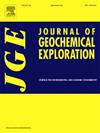江南钨矿带仙霞岩体和竹西岭钨矿晚中生代花岗岩成因及成矿控制因素
IF 3.3
2区 地球科学
Q1 GEOCHEMISTRY & GEOPHYSICS
引用次数: 0
摘要
在全球范围内,大多数钨矿床与花岗岩有着密切的遗传关系,但只有少数花岗岩可以形成钨矿床。到目前为止,含矿花岗岩形成的控制因素仍是一个不断讨论的话题。为探讨成矿花岗岩的主控因素,对江南钨矿带仙霞贫岩和竹西岭成矿侵入体进行了锆石年代学、磷灰石原位地球化学、全岩主微量元素和Sr-Nd-Pb同位素的综合研究。锆石UPb定年结果表明,仙霞(133.8 ~ 140.1 Ma)和竹西岭(139.5 ~ 143.3 Ma)侵入体发育于早白垩世。仙峡和竹西岭样品(SiO2 = 62.04 ~ 70.40 wt%)主要为高钾钙碱性、弱过铝质二长花岗岩和正长花岗岩,表现出弱分选i型花岗岩的亲缘性,表现为lree、Rb、Th、U富集,Eu、Nb、P、Ti负异常(δEu = 0.68 ~ 0.90)。它们还具有较高的Sr含量(247ppm ~ 549ppm)和Sr/Y比值(19.45 ~ 39.50),负的全岩εNd(t)值(−6.4 ~−5.0),高放射性成因的Pb同位素组成,以及高的logfO2值(−22.03 ~−11.35)。化学和同位素特征表明,仙峡和竹西岭岩体可能是新元古代地壳成分与少量幔源岩浆流入混合形成的。与仙夏样品(磷灰石中Kdap-melt OH-F = 0.0047 (avg), Kdap-melt OH-Cl = 0.0912 (avg))相比,竹西岭样品卤素分配系数(磷灰石中Kdap-melt OH-F = 0.0089 (avg),磷灰石中Kdap-melt OH-Cl = 0.1034 (avg)), Sr和水含量(磷灰石和锆石中分别为0.4762 wt%和3.37 wt%)更高,更有利于钨的富集。综合判别分析表明,弱分选i型花岗岩钨矿化受岩浆高sr含量、碱度升高、水氟含量升高和流体动力学活动的影响。研究结果为了解花岗岩体系中钨矿的形成条件提供了有价值的见解,对类似地质环境下的勘探策略具有更广泛的意义。本文章由计算机程序翻译,如有差异,请以英文原文为准。
Petrogenesis and factors controlling tungsten mineralization of Late Mesozoic granites from Xianxia intrusion and Zhuxiling tungsten deposit in Jiangnan tungsten belt, China
Globally, most tungsten deposits are closely and genetically related to granitic rocks, but only a small amount of granite can produce tungsten deposits. So far, there are still a topic of ongoing discussion about the controlling factors of ore-bearing granite formation. To investigate their controlling factors of the ore-forming granites, an inclusive research of zircon geochronology, apatite in-situ geochemistry, whole-rock major-trace elements and Sr-Nd-Pb isotopes was carried out for the Xianxia barren and Zhuxiling ore-forming intrusions in Jiangnan tungsten belt, China. Zircon U![]() Pb dating results show that Xianxia (133.8–140.1 Ma) and Zhuxiling (139.5–143.3 Ma) intrusions were emplaced in the Early Cretaceous. The Xianxia and Zhuxiling samples (SiO2 = 62.04–70.40 wt%) predominantly are high-K calc-alkaline, weakly peraluminous monzogranite and syenogranite, exhibiting an affinity of weakly fractionated I-type granite, characterized by enrichment in LREEs, Rb, Th, and U, and negative anomalies in Eu (δEu = 0.68–0.90), Nb, P, and Ti. They also have relatively high Sr contents (247–549 ppm) and Sr/Y ratios (19.45–39.50), negative whole-rock εNd(t) values (−6.4 ∼ −5.0), high radiogenic Pb isotopic compositions, as well as high logfO2 values (−22.03 to −11.35). The chemical and isotopic characteristics show that the Xianxia and Zhuxiling intrusions were likely derived from the mixing of Neoproterozoic crustal components with a little influx of mantle-derived magma. Compared with Xianxia samples (Kd ap-melt OH-F = 0.0047 (avg.) and Kdap-melt OH-Cl = 0.0912 (avg.) in apatite), Zhuxiling samples have higher halogen partitioning coefficient (Kd ap-melt OH-F = 0.0089 (avg.) and Kdap-melt OH-Cl = 0.1034 (avg.) in apatite), Sr and water contents (0.4762 wt% and 3.37 wt% of apatite and zircon), suggesting that it is more conducive to tungsten enrichment. A comprehensive discriminant analysis highlights that tungsten mineralization in weakly fractionated I-type granites is influenced by high-Sr content magma, increased alkalinity, elevated water and fluorine content, and active fluid dynamics. The results offer valuable insights into the conditions necessary for tungsten deposits in less evolved granitic systems, with broader implications for exploration strategies in similar geological settings.
Pb dating results show that Xianxia (133.8–140.1 Ma) and Zhuxiling (139.5–143.3 Ma) intrusions were emplaced in the Early Cretaceous. The Xianxia and Zhuxiling samples (SiO2 = 62.04–70.40 wt%) predominantly are high-K calc-alkaline, weakly peraluminous monzogranite and syenogranite, exhibiting an affinity of weakly fractionated I-type granite, characterized by enrichment in LREEs, Rb, Th, and U, and negative anomalies in Eu (δEu = 0.68–0.90), Nb, P, and Ti. They also have relatively high Sr contents (247–549 ppm) and Sr/Y ratios (19.45–39.50), negative whole-rock εNd(t) values (−6.4 ∼ −5.0), high radiogenic Pb isotopic compositions, as well as high logfO2 values (−22.03 to −11.35). The chemical and isotopic characteristics show that the Xianxia and Zhuxiling intrusions were likely derived from the mixing of Neoproterozoic crustal components with a little influx of mantle-derived magma. Compared with Xianxia samples (Kd ap-melt OH-F = 0.0047 (avg.) and Kdap-melt OH-Cl = 0.0912 (avg.) in apatite), Zhuxiling samples have higher halogen partitioning coefficient (Kd ap-melt OH-F = 0.0089 (avg.) and Kdap-melt OH-Cl = 0.1034 (avg.) in apatite), Sr and water contents (0.4762 wt% and 3.37 wt% of apatite and zircon), suggesting that it is more conducive to tungsten enrichment. A comprehensive discriminant analysis highlights that tungsten mineralization in weakly fractionated I-type granites is influenced by high-Sr content magma, increased alkalinity, elevated water and fluorine content, and active fluid dynamics. The results offer valuable insights into the conditions necessary for tungsten deposits in less evolved granitic systems, with broader implications for exploration strategies in similar geological settings.
求助全文
通过发布文献求助,成功后即可免费获取论文全文。
去求助
来源期刊

Journal of Geochemical Exploration
地学-地球化学与地球物理
CiteScore
7.40
自引率
7.70%
发文量
148
审稿时长
8.1 months
期刊介绍:
Journal of Geochemical Exploration is mostly dedicated to publication of original studies in exploration and environmental geochemistry and related topics.
Contributions considered of prevalent interest for the journal include researches based on the application of innovative methods to:
define the genesis and the evolution of mineral deposits including transfer of elements in large-scale mineralized areas.
analyze complex systems at the boundaries between bio-geochemistry, metal transport and mineral accumulation.
evaluate effects of historical mining activities on the surface environment.
trace pollutant sources and define their fate and transport models in the near-surface and surface environments involving solid, fluid and aerial matrices.
assess and quantify natural and technogenic radioactivity in the environment.
determine geochemical anomalies and set baseline reference values using compositional data analysis, multivariate statistics and geo-spatial analysis.
assess the impacts of anthropogenic contamination on ecosystems and human health at local and regional scale to prioritize and classify risks through deterministic and stochastic approaches.
Papers dedicated to the presentation of newly developed methods in analytical geochemistry to be applied in the field or in laboratory are also within the topics of interest for the journal.
 求助内容:
求助内容: 应助结果提醒方式:
应助结果提醒方式:


